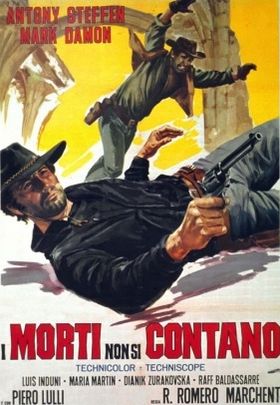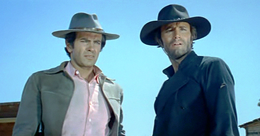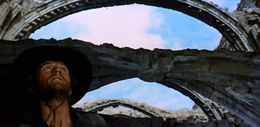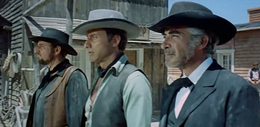Dead Men Don't Count Review: Difference between revisions
No edit summary |
No edit summary |
||
| Line 1: | Line 1: | ||
{| align=right width="285px" style="border:2px solid gray; padding:5px; margin:5px;" | | {| align=right width="285px" style="border:2px solid gray; padding:5px; margin:5px;" | | ||
|[[File:Dead_men.jpg|280px]] | |[[File:Dead_men.jpg|280px]] | ||
| Line 81: | Line 79: | ||
[[Category:Dyanik Zurakowska]] | [[Category:Dyanik Zurakowska]] | ||
[[Category:Luis Barboo]][[Category:Carlos Romero Marchent]] | [[Category:Luis Barboo]][[Category:Carlos Romero Marchent]] | ||
--By '''[[User:Scherpschutter|Scherpschutter]]''' | --By '''[[User:Scherpschutter|Scherpschutter]]''' | ||
''Special thanks to '''Yoshi Yasuda''''' | ''Special thanks to '''Yoshi Yasuda''''' | ||
Revision as of 13:20, 1 March 2014

|
Director:
Cast:
Music:
|
| Two bounty hunters get involved in a local war when they associate themselves with homesteaders who are threatened by a corrupt businessman who knows the impending railroad will be going through their lands. This buddy movie seems to announce the Trinity formula, but the body count is pretty high and the violence occasionally quite nasty. Uneven but lively, with lots of action and both Steffen and Damon in good form. |
Dead Men Don't Count (¿Quién grita venganza?)
Italian title: I morti non si contano

|
A lesser known paella-spaghetti western by the younger of the two Marchent brothers, Rafael Romero. Barely noticed at the time, it has found its audience in recent years. With a fairly light-hearted approach and the pairing of two buddies it seems to herald the Trinity formula, but the background story is flirting with melodrama and the body count is pretty high.
The first minutes are quite confusing; the movie opens with a scene of an adulterous woman plotting to kill her husband with the help of her lover, then we get a seemingly unrelated scene with Anthony Steffen and Mark Damon causing a bloodbath within the ruins of a monastery. It's a bizarre spectacle, the more so because the credits are played over it, resulting in a series of freeze frames of moribund people falling from great heights, making a full stop in mid-air (1). When the two men arrive in the town of Blackstone, it becomes clear that we have jumped forward some twenty years in time between the two scenes. The murderous lover from the opening scene has become a wealthy businessman, with a different hair color and an army of professional gunmen to protect his interests. He's trying to chase the local homesteaders off their land because it will be worth a fortune in the near future with the impending railroad scheduled to go through it. We also meet the woman of the opening scene, now married to the businessman, who seems to think - because of the guns he's wearing - that Damon is her son, the one she disowned after the violent death of her husband.

|

|
You might have noticed that the movie has quite a busy script. It tries - not completely unsuccessfully - to prolong the suspense with a few suggestive hints and this background story of adultery, murder and a long lost child. It's lively, full of action - but the cheerful banter of the two buddies (they even seem to have a lot of fun while doing their killings) doesn't always mix well with the brutal violence of this war fought over land, in which entire families are slaughtered. Some plot elements feel a little artificial too; a love story is thrown in but not properly developed (we would've liked to see more of this blonde girl) and Damon and Steffen kill so fast that halfway the movie a new army of professional gunman must be recruited in order to keep them busy. There's certainly no shortage of gratuitous violence.
The film reminded me a little of Giuliano Carnimeo's The Moment to Kill, released the same year; the glory days were coming to an end and the industry was looking for ways to breathe new life into the genre. Both movies offer a combination of western and thriller elements and feature two buddies interfering in a local conflict; both also have a vulnerable woman (in Carnimeo's movie a handicapped young girl, in this movie a mother struggling with feelings of remorse) who's essential to the plot and involved in a ironic twist ending. In the case of this movie, this twist ending is simple but quite effective.
The two stars are both cast-against-type: Damon, best known for playing conceited, self-important types, is remarkably affable, while Steffen, usually the epitome of woodenness, is even more cheerful here than he was in A Train for Durango. They play very well together but there's probably not enough contrast in their characters to make it all work to perfection: Damon is a bon vivant and a hothead, Steffen a more worldwise schemer, but there's no Hill and Spencer effect of the quicksilver hedonist and the bad-tempered hulk, they're both jovial types, enjoying each others' company. It would still take some tinkering to get to the right formula.
Note:
- (1) The scene was shot at "Pelayos de la Presa" near Villamanta, a location used in a couple of westerns, the most notable of them being Vamos a Matar, Compañeros (Please scroll down):
Giombini or Ortolani?
No, this is not a popularity poll. Two composers are mentioned in relation to the film's score, their names appearing on different versions. Giombini is listed on Soundtrack Collector, Ortolani on IMDB. It has been suggested that two different scores were composed, one by each composer. In this vision their work was simply used for different versions. However, on the copy used for the Spanish DVD, Ortolani is credited, but on the forum Chris Casey and Silver - both far more competent in this aspect than I am - sustain that the score has Giombini written all over it; Silver adds that the score is very similar to the one Giombini did for Garringo. Soundtrack collector Ennioo states: "The style of guitar, banjo and organ work on the soundtrack gives me no doubt the score is by Giombini, like Silver and Chris mention."
--By Scherpschutter
Special thanks to Yoshi Yasuda



